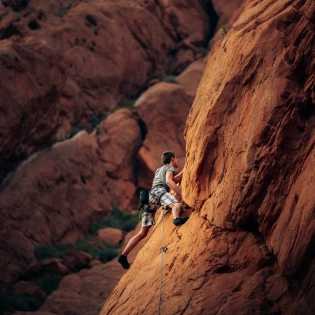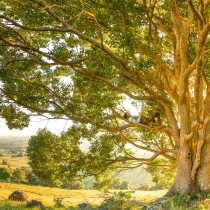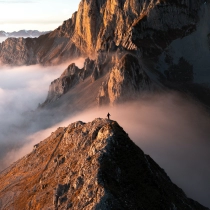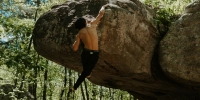

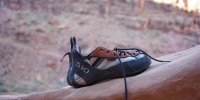



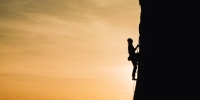
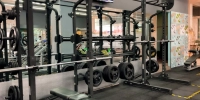
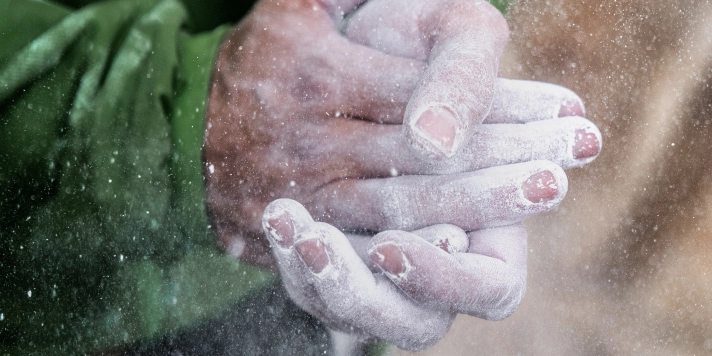
general climbing
Part of a rock climbers training is to be able to climb for longer periods of time. They do this by doing endurance training, which allows them to scale up very tall walls and long routes.
This also comes in to play with bouldering. Climbers are able to have long 3-4 hour climbing sessions by resting in between routes and attempts. The amount of time each climber rests depends on the climber, their endurance, and the route being climbed.
Generally, it's not abnormal for climbers to spend over 6 hours climbing. It's just the nature of the sport. Climbers are not constantly exerting energy the whole climbing session, they are resting enough time in between attempts to allow them to make the most out of each training session.
Even when climbing a big wall and a long route, climbers are able to find certain spots on the route to rest. And this is where climbers excel. Climbers can find spots to rest mid-route that would seem impossible to non-climbers. These spots could be very small hand holds, but for a climber, this could be all they need to recover some of their energy, reduce the pump in their forearms, and continue climbing.
There is no one correct way of climbing since every climber can have their own climbing style, and strengths. Though, there are a few general concepts that can help you climb better:
-
Use your feet - Climbing is not just an arm and back sport, contrary to what many believe. It also heavily relies on other things, such as proper footwork. If you rely on just your arms and back muscles for climbing, you will soon find out that you cannot progress as quickly as you would like. Having proper footwork is key to better climbing, as most of your weight should be on your feet, and not held by your arms.
-
Keep your arms straight - This is an important part of reserving strength while climbing. If you consistently lock off (holding your body weight with bent arms), you will very quickly lose strength and stamina, and will end up just falling and not completing the route. Allowing your arms to straighten out helps transfer your body weight to your skeleton, which reduces the tension and load on your muscles, allowing you to climb longer and reserve the much required power for later moves.
-
Technique - Sure, you can climb some routes by just pulling yourself up with your arms, but at some point, the routes will require you to have increasingly better technique. Good technique is better learned from the beginning, rather than later on after you have gotten use to relying on your strength alone. With proper technique, you are able to climb longer by reserving stamina and strength.
-
Read the route - Another key element in being able to climb hard routes and to preserve energy and power is to learn how to read the climbing routes rather than just getting on them and trying to figure it out on the wall. Trying to figure out a route while on the wall and where the next holds are and how to reach them just takes a lot of precious time that will cost you a lot of energy and strength. Reading the route and understanding it before getting on it allows you to see the holds, understand how to get to them and hold them, and gives you a general map of the route for you to follow. This helps reserve energy and strength and can be the difference between reaching the top and falling.
Rock climbers are very efficient at pacing themselves, and only exerting the required amount of energy, and no more. They achieve this through training, experience, and properly reading the route.
Climbers do in fact get tired, just after a different amount of time than others, and they are able to handle it better than others.
In order for a climber to complete a route, which can sometimes very long and physically demanding, they must first understand the route and it's requirements, and what options they have that can help them finish it. Based on that, and on an understanding of what their own strengths are, they will decide on the beta that suits them best.
Knowing what they need to do on the route and properly reading it and coming up with the correct beta for themselves also allows them to find good resting spots. These resting spots are crucial for long and tough routes, as the climber can spend enough time in these resting spots to recover and to reduce the pump in their arms.
Climbers also train very hard in order to reduce the effects of the pump they feel in their arms, so that they are able to climb through it better, and to delay the pump from ever happening.
Traditional indoor boulder walls are usually around 15 feet (4.5 meters) tall.
This is not an indication for how long the actual route is, though, since the climbing route may actually be shorter or longer than the wall itself due to the angle of the wall, and to the structure and design of the routes. If the wall is very overhanging, the wall or boulder may be shorter than 15 feet, but the route itself could be longer. Imagine a cave ceiling, it could be rather short in height from the ground, but, the route could span much of the actual cave ceiling, making the route much longer than the actual height of the cave.
Outdoor boulders can be of any height really, though at some point they are considered sport climbing routes, but generally, outdoor boulders can be much taller than 15 feet.
Rock climbing is a great sport as really almost anyone can do it, regardless of their fitness level.
There are a few types of climbing, but the simplest one is indoor bouldering. Boulders are short routes, usually up to 15 feet (around 5 meters) tall. You don't really need any equipment besides climbing shoes, and a chalk bag, but even those can usually be provided by the climbing gym.
The goal of bouldering is to climb from point A to point B. The rules are fairly simple, though each climbing gym may have their own variation of the rules. The basic rules are to start from the starting hold, and to finish the route by touching the finish hold with two hands. There is a mat at the bottom of the routes to make falling/getting down safe.
The reason why this is the simplest form of climbing, mainly for beginners, is because it’s very simple to just start climbing, you do not need to depend on anyone, you can do it alone, and the beginner routes are just very easy to climb, they are very much like climbing ladders. As you progress in the grades, the routes will become more complex and physically demanding, but also mentally demanding.
This is where things start to get more interesting, and why people looking to start a new sport should consider rock climbing. Climbing is not only a physical sport, it is also a mental one. You can think about climbing and boulder problems as puzzles. Your goal is to solve the puzzle by understanding the route, it's requirements, and how you can physically complete the puzzle. To do this you have to understand what the route requires from you, and what your physical strengths are, skills, and technique.
There is a lot of thought and puzzle solving that goes into climbing, it's not just a matter of getting on the route and climbing to the top with all the strength you have, sometimes the routes require far more technique than strength.
Climbers sand their fingers to prevent skin injuries such as flappers, cracks and tears. This happens due to calluses building up.
Climbing is pretty rough on the skin, and after doing it for a while, you start developing calluses. This is a natural process of the body and is meant to protect the skin. The problem climbers have, is that after some time, the calluses can actually build up and cause potential skin injuries.
The skin injuries can occur due to different reasons, such as the callus area being very dry, or when a callus is caught or pinched on a hold, which can cause the callus to peel off, which is known as a flapper.
Climbers tend to sand down the calluses to reduce their size, and make them a little bit smoother so that they don't get caught and rip off.
Because it is both a physical challenge, and also a mental challenge. Yes, many sports include a mental challenge, but climbing specifically requires problem-solving skills.
The sport requires you to understand the routes, to understand your options and how to get to the top. A rock climbing route is essentially a puzzle that you need to solve. Solving it is both a mental and physical challenge. To solve it, you need to understand the route, how it's built and what it requires, and you need to understand what your capabilities and skills are. Then you need to use those understandings to find the best way to reach the top for you.
This is another great part of the sport - there is no one correct way to reach the top.
Every climber can have their own climbing style, some are more powerful, some are more technical, some combine the two. Some prefer crimpy holds, some prefer pinches. Some are flexible, some are not.
Every one of these elements, and more, contribute to the climbing style of the climber, which makes each climber quite unique in the way they climb, and in the way they solve the puzzles (climb the routes).
This means that you may see 10 people reaching the top of a route, and each of them may have done it in a slightly different way, and you yourself may also do it in a different way.
Yes! Bouldering is one of those sports that you really don't need anyone with you to do it, you can sign up to a climbing gym and just start climbing.
It's a very friendly sport, most climbers are very helpful, open and willing to help others and climb with others, if of course that is what you want, if not then you can always just go and climb on your own.
It does help to climb with others, it helps when you have others to bounce ideas of off, or to learn from, but even if you want to go and climb alone as a hobby, a meditative practice, or what ever the reason, you can just go and do it.
If you are asking about outdoor bouldering, then the answer is no, you will need additional people with you to keep you safe and watch over you as you climb. Climbing gyms are different in this aspect as the routes are usually built much safer than the routes you may find outdoors, they are usually also shorter, so even if you fall, you don't fall from very height up. In gyms, you also fall on climbing mats, which are basically mattresses that soften your fall, whereas with outdoor bouldering you will need to bring enough crash pads to cover the area below you, which can add to the risk if not well-prepared.
You do need certain levels of upper and lower body strength, but, the amount of strength really depends on the grade you want to climb.
If you are a beginner, then you don't really need any extra strength to start climbing, as the beginner level routes are very easy. They are similar to climbing ladders, just with some curves.
If you want to climb harder grades, then yes you will need upper body strength, and lower body strength also. Though, by the time you get to these harder routes, you will probably build up that strength anyway through your climbing journey to those grades, and if not, you can include some additional training into your schedule.
Just to point this out though, I have quite a bit of upper body strength as I have been lifting weights for many years on and off, and I climb v7/v8 normally. I have a friend who is significant weaker than me, but, he climbs v8+ and is a much better climber than me. The point is that even if you do not have a lot of upper body strength, you can still be a great climber and climb hard routes. The upper body strength helps, but it's really a combination of strength and technique that will make the biggest difference.
Bouldering does not require a climbing partner, so if you cannot find someone to go with, then that is ok. Bouldering required extra people when you do it outdoors, since you will need crash pads and spotters to watch over you while you climb. Indoor bouldering, though, does not require more people as the gyms have types of mattresses that you fall on, and the bouldering walls are usually at a max height of 15 feet (around 5 meters), while some are even shorter.
Besides the technical aspect, though, bouldering, and climbing in general, is a very friendly sport, at least from my own experience and that of many others. Climbers are usually very welcoming and helpful, so even if you go and climb alone, you can meet new people that can help you or that you can climb with. It's a great place to meet new people.
If, on the other hand, you want to climb alone and not be bothered, that is of course also an option.

